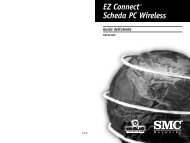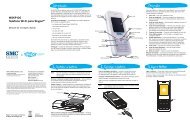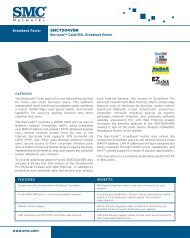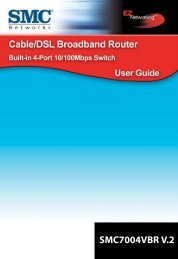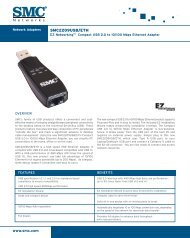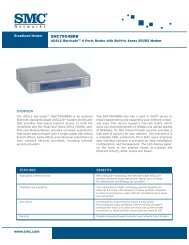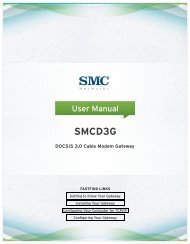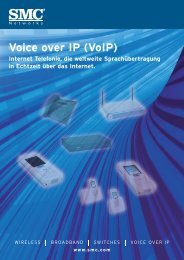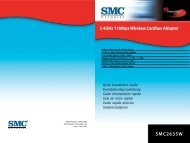PRODUCT CATALOG - SMC
PRODUCT CATALOG - SMC
PRODUCT CATALOG - SMC
Create successful ePaper yourself
Turn your PDF publications into a flip-book with our unique Google optimized e-Paper software.
BOOTROM (OR BOOTPROM)<br />
A chip installed on the network card that typically contains<br />
networking software to start a remote-boot client.<br />
BOOTP (BOOT PROTOCOL)<br />
Protocol used for the static assignment of IP addresses<br />
to devices on the network.<br />
BPSK (BINARY PHASE SHIFT KEYING)<br />
Modulation technique used by IEEE 802.11-compliant<br />
wireless LANs for transmission at 1Mbps.<br />
BRIDGE<br />
A bridge is an alternative to connecting two or more<br />
separate LANs with cable. With a wireless bridge you<br />
gain wireless connectivity between two or more remote<br />
LANs.<br />
BROADCAST STORM<br />
Multiple simultaneous broadcasts that absorb available<br />
network bandwidth and can cause network time-outs.<br />
BROWSER<br />
In brief, a browser is your interface to the World Wide<br />
Web; it interprets hypertext links and lets you view sites<br />
and navigate from one Internet node to another. Among<br />
the companies that produce browsers are e.g. Netscape,<br />
and Microsoft, as well as commercial services like<br />
CompuServe, Prodigy, and America Online.<br />
BUS<br />
An electrical connection which allows two or more lines<br />
to be connected together. Circuit cards with the proper<br />
address will be able to access the appropriate information<br />
from the bus, as the same information travels to all<br />
destinations.<br />
CARDBUS<br />
Cardbus is a specification that allows PCMCIA cards to<br />
transfer data at rates exceeding 100Mbps. Older, 16-bit<br />
PCMCIA cards transfer data at a rate of 20MB/sec.<br />
CARRIER<br />
This is another name for a phone connection. When you<br />
see the external modem light labeled CD flash, you know<br />
the modem is receiving a carrier detect (CD) signal, and<br />
that it's hooked up to another computer.<br />
CBR (CONSTANT BIT RATE)<br />
CBR is related to Class A Quality of Service and<br />
often associated with premium transmission<br />
service.<br />
CCK (COMPLEMENTARY CODE KEYING)<br />
CCK is the coding method associated with<br />
IEEE 802.11b wireless devices.<br />
CCK-OFDM<br />
An optional transmit mode defined by<br />
the IEEE802.11g standard that combines<br />
the access modes of IEEE<br />
802.11a and IEEE<br />
802.11b; capable of<br />
supporting transmission<br />
speeds of<br />
up to 22Mbps.<br />
SUPPORT & SERVICE<br />
GLOSSARY<br />
40<br />
CHAP (CHALLENGE HANDSHAKE AUTHENTICATION<br />
PROTOCOL)<br />
Security feature supported on lines using PPP<br />
encapsulation that prevents unauthorized access. CHAP<br />
does not itself prevent unauthorized access, it merely<br />
identifies the remote end. The router or access server<br />
then determines whether that user is allowed access.<br />
CLASS I REPEATER<br />
Fast Ethernet repeater that performs translations when<br />
transmitting or repeating incoming signals to enable<br />
different physical media to be connected to the same<br />
collision domain; which may have a MII interface.<br />
CLASS II REPEATER<br />
Fast Ethernet repeater that immediately transmits or<br />
repeats incoming signals to other devices on identical<br />
media.<br />
COMBINATION CARDS<br />
Combo cards are a class of EN1650 cards that combine<br />
two or more functions in one card, there by extending<br />
the applications available from the single slot found<br />
in most platforms. The most common are data/fax<br />
modems combined with network interface cards (NICs).<br />
CSMA/CA (CARRIER SENSE MULTIPLE ACCESS/<br />
COLLISION AVOIDANCE)<br />
Multiple access scheme that uses Direct Sequence<br />
Spread Spectrum (DSSS) code sequences as traffic<br />
channels in a common radio channel.<br />
CSMA/CD<br />
(Carrier Sense Multiple Access/Collision Detection)<br />
Baseband communications access method that uses<br />
a collision-detection technique. When a device wants<br />
to gain access to the network, it checks to see if the<br />
network is free. If it is not, it waits for a random amount<br />
of time before retrying. If the network is free and two<br />
devices attempt access at exactly the same time, they<br />
both back off to avoid a collision and each wait a random<br />
amount of time before retrying.<br />
CUT-THROUGH<br />
A type of forwarding method used in switches that<br />
allows data to be forwarded through without any checks<br />
due to the low error rate of the network.<br />
DAISY CHAIN<br />
Arrangement of computer components connected in<br />
series, one after the other.<br />
DATA PACKET<br />
Although your computer and modem can send data one<br />
character at a time, when you're surfing the Internet,<br />
downloading files, or sending email, it's more efficient<br />
to send information in larger blocks called data packets.<br />
Modems generally send packets of around 64 characters<br />
along with some extras for error checking. When using<br />
Internet protocols such as TCP/IP, the packets are<br />
around 1,500 characters large.<br />
DB CONNECTOR (DATABASE BUS CONNECTOR)<br />
Type of connector used to connect serial and parallel<br />
cables to a data bus. DB connector names are of the<br />
format DB-x, where x represents the number of wires<br />
within the connector. Each line is connected to a pin<br />
on the connector, but in many cases, not all pins are<br />
assigned a function. DB connectors are defined by<br />
various EIA/TIA standards.




